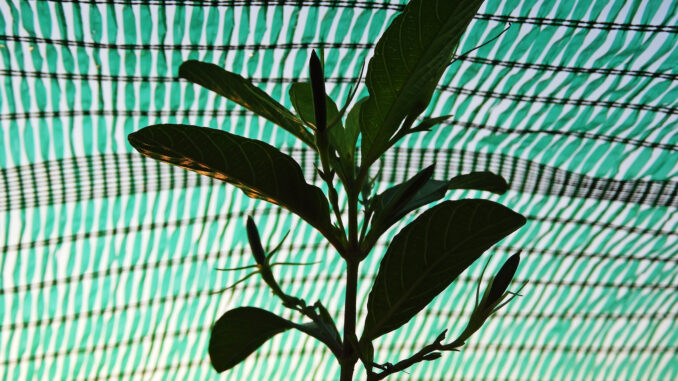

Laurel Thompson | Fort Collins Nursery
The dog days of summer are lingering on, leaving some outdoor plants dry, droopy, or just plain scorched. It’s normal for our vegetable gardens to suffer a bit when temperatures reach into the 90s, but luckily there are a few things we can do to give them some much-needed relief.
INVEST IN SHADE CLOTH
Never underestimate the power of shade cloth, especially here in Colorado. Our high elevation and hot summer days mean even well-watered plants can wilt in the afternoon sun, so it’s always a good idea to set up some artificial shade where there aren’t any trees to diffuse the light. Hanging shade cloth in the garden is easy: simply hammer a few posts into the ground and secure the cloth with grommet clips, or add fittings along the sides and use string to tie it to a fence.
Shade cloth usually comes in black and green, and percentages typically range from 30-60 percent, though some provide even greater protection for shade plants. When purchasing shade cloth for a vegetable garden, choose a lower percentage for heat-loving plants like peppers, tomatoes, and cucumbers, and opt for a higher percentage to protect heat-sensitive plants like lettuce, spinach, and snap peas. When in doubt, a 50 percent shade cloth usually works great for veggie gardens in the afternoon sun.
CATCH THE MORNING SUN
Another way to minimize heat stress is to plant vegetables in an area that gets direct sun in the first half of the day rather than in the late afternoon. Morning light is much gentler on plants because it doesn’t have the intense heat that comes with direct sun on the west side of the house. Speaking from experience, most vegetables and herbs do well with about six hours of direct sun transitioning to shade by one or two o’clock.
If it isn’t possible to plant vegetables in a spot with morning sun, hang shade cloth or find a place in the yard with trees that’ll shield them from the late afternoon rays. Linden trees, honeylocusts, maples, and catalpas all provide great shade throughout the summer, with leafy foliage dispersing the light for a much gentler growing environment. Tall shrubs such as mountain mahogany, buckthorns, and serviceberries, can also provide great protection.
WATER IN THE MORNING
Aside from providing afternoon shade, another way to protect our gardens from heat stress is to water in the morning as opposed to the afternoon. Watering when temperatures are lower allows the plants to get a good drink before the heat of the day causes them to evaporate. Not only that, but the slower morning evaporation also helps to keep the ambient temperature of the garden lower a bit longer. When water has a chance to evaporate off the leaves in the gentle morning light, the risk of leaf burn from water droplets is also much lower (though it is best to avoid getting water on the leaves at all).
This time of year, many of us will need to water our gardens twice per day to keep plants from drying out, and adding mulch or grass clippings around our plants will help to keep them hydrated longer. Even if some plants are showing signs of heat stress now, a little extra water and shade will help tide them over until temperatures start to cool back off in late August. Then the fall harvest begins!
Support Northern Colorado Journalism
Show your support for North Forty News by helping us produce more content. It's a kind and simple gesture that will help us continue to bring more content to you.
BONUS - Donors get a link in their receipt to sign up for our once-per-week instant text messaging alert. Get your e-copy of North Forty News the moment it is released!
Click to Donate
